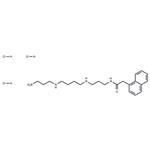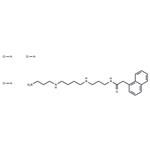naspm trihydrochloride is a selective antagonist of ca2+-permeable α-amino-3-hydroxy-5-methyl-4-isoxazole propionic acid (ampa) receptors. ampa receptors are glutamate-gated ion channels that play central roles in the mammalian brain, mediating fast excitatory synaptic transmission and underlying several forms of synaptic plasticity. on excitatory neurons in adult animals, two types of ampa receptors are primarily expressed, namely heteromeric channels composed of glur1 and glur2 subunits (glur1/2 receptors), as well as channels composed of glur2 and glur3 subunits (glur2/3 receptors). naspm trihydrochloride blocks ampa receptors lacking the glur2 subunit, with an ic50 value of 0.3 μm for glur1 homomers.1. nilsen a, england pm. a subtype-selective, use-dependent inhibitor of native ampa receptors. journal of the american chemical society, 2007, 129(16): 4902-4903.2. koike m, iino m, ozawa s. blocking effect of 1-naphthyl acetyl spermine on ca2+-permeable ampa receptors in cultured rat hippocampal neurons. neuroscience research, 1997, 29(1): 27-36.



